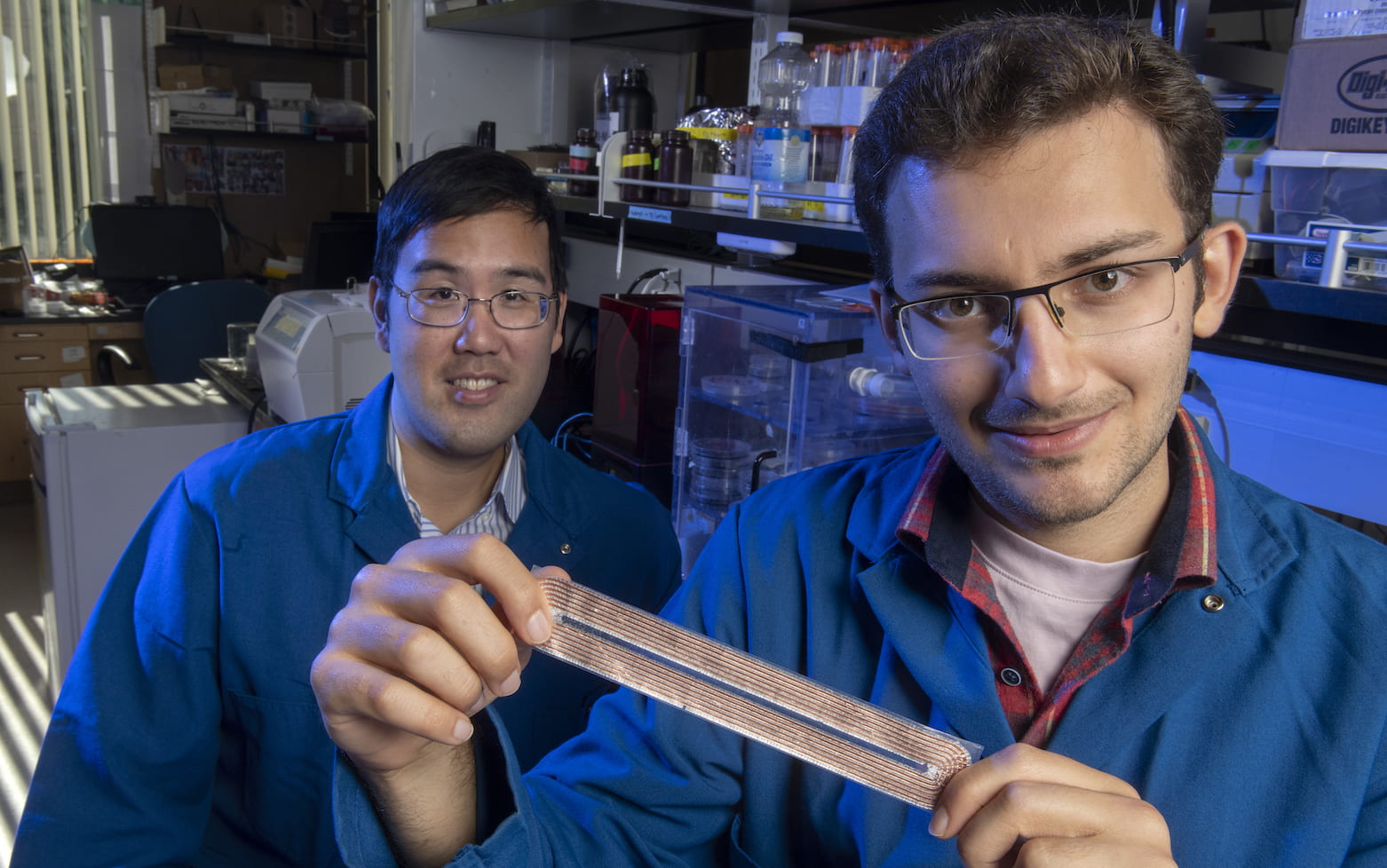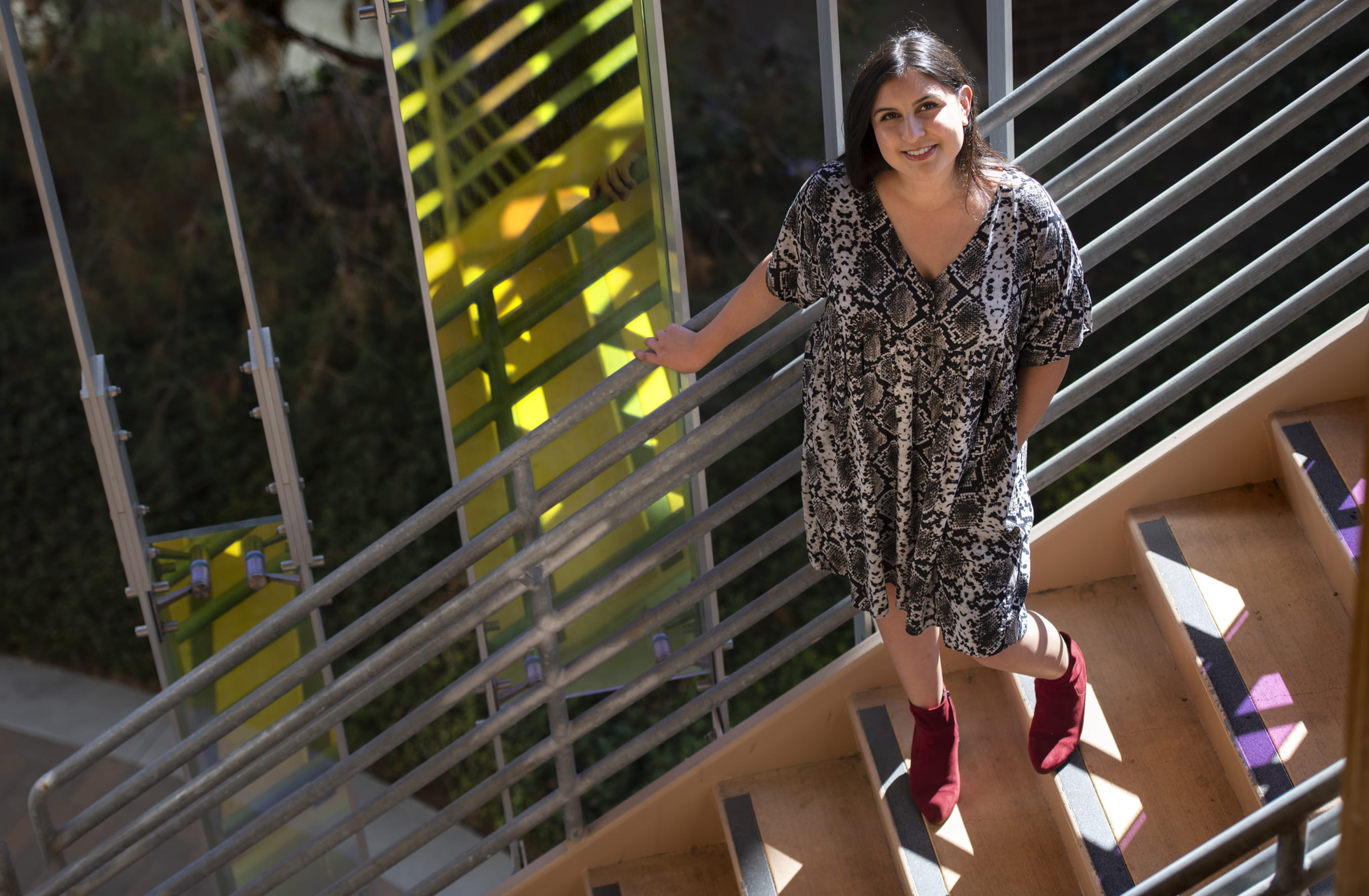
Laser-focused on science education
Desiré Whitmore, also known as LaserChick, is a physicist and advocate for underrepresented groups in STEM
Who is LaserChick? Is she a tattoo artist? The latest TikTok star? A new Marvel hero?
Desiré Whitmore may not be a hero in the comic-book sense, but the self-described Blaxican American physicist whose moniker is LaserChick is indeed an inspiring role model for children – especially girls – from underrepresented communities who are interested in STEM careers. In her role as a staff physicist educator for the Teacher Institute of San Francisco’s Exploratorium, Whitmore, who earned a Ph.D. at UCI in 2011, amplifies her impact on the next generation of learners by developing and teaching hands-on activities that middle and high school teachers can use to spark their students’ interest in and excitement about science.
In a photo on Whitmore’s website, laserchick.net, she points to herself and holds up a sign saying: “This is what a scientist looks like.” It’s something she couldn’t have imagined while growing up in small, rural towns in the Antelope Valley. Resources were scarce in both her family of eight kids and the local school district. The admitted math and band nerd fed her immense curiosity by taking things apart: the telephone, TV, vacuum cleaner, Nintendo console, VCR. “I just did it for fun because I wanted to know how it all worked,” Whitmore says.
After community college and then getting a bachelor’s degree in chemical engineering at UCLA, she came to UCI to earn a master’s and a doctorate in chemical and material physics. “I thought, ‘This is my dream: chemistry and physics together,’” she says. “I got to pick and choose classes in physics, engineering, chemistry and math and make this really cool Jenga tower of a Ph.D. for myself.”
Whitmore’s obsession with quantum mechanics drew her to the labs of two of her chemistry professors – Eric Potma and Ara Apkarian – at the National Science Foundation-funded Center for Chemistry at the Space-Time Limit. “As soon as I saw the giant laser systems in Ara’s lab, I was hooked,” she says.
At a weeklong training session for those laser systems, she pressed the instructor to share everything he knew. “By the end, I was an expert not just in those systems but in lasers in general,” Whitmore says. For her doctoral project, she built femtosecond (one-quadrillionth of a second) lasers to study single molecules vibrating in real time. “The ability to control laser pulses at that level felt really incredible,” she says.
While she relished working with lasers, Whitmore felt lonely in the lab. She volunteered to teach lasers and optics to children at outreach events. She shared her email address with kids interested in learning more but realized she needed an easier-to-remember name. Her LaserChick identity was born.
In 2011, she won the prestigious University of California President’s Postdoctoral Fellowship to continue her laser research at UC Berkeley, where she built attosecond (onequintillionth of a second) laser systems to study electrons traveling across metal and semiconductor surfaces. As the postdoc neared its end in 2014, Whitmore struggled to figure out her path. “I was applying to jobs where I would keep playing with lasers, but they wouldn’t stretch any of my other muscles: my science communication, my teaching or my curiosity,” she says. “I realized that teaching and outreach were really what I loved doing.”
She read the self-help book What Color Is Your Parachute? Three of the four dream careers it recommended for her were spot on: teacher, science movie advisor and museum scientist. “I didn’t even know ‘museum scientist’ was a job,” Whitmore says.
Immediately, she leaped on an opening as a science curriculum specialist in the Learning Design Group at UC Berkeley’s Lawrence Hall of Science. The group had just contracted with the company Amplify to develop its namesake K-8 science curriculum based on newly released educational standards. “It was so fun,” Whitmore says. “I realized: ‘This is what I want.’”
She’s most proud of her eighth grade unit on light waves, which has been adopted in nearly 40 states, in such huge urban districts as Chicago and Seattle, and countless smaller regions – including in the Antelope Valley. “I’m teaching children in an area where my own education wasn’t amazing,” she says. “But I’m helping to change that.”
In 2018, after two years of teaching about lasers and photonics technology at Irvine Valley College, Whitmore seized the opportunity to combine two dream jobs into one at San Francisco’s Exploratorium, a public learning laboratory dedicated to exploring the world through science, art and human perception. As a staff physicist educator in the Exploratorium’s Teacher Institute, she educates middle and high school teachers on how to relay science in an inquiry driven manner and use students’ own curiosity to help them learn science.
Whitmore draws inspiration from the Exploratorium’s hundreds of hands-on exhibits to create physics-centered Science Snacks, short activities that employ inexpensive everyday materials to bring explorations of natural phenomena into the classroom and home. For example, the “Laser Speckle” activity uses a frosted lightbulb and dollar-store laser pointer to demonstrate the phenomenon of wave interference, which appears differently to people who are nearsighted, are farsighted or have 20/20 vision. The “Laser Jell-O” activity uses a laser pointer and gelatin to demonstrate differences in light absorption, refraction and reflection.
The accessible nature of the hundreds of Science Snacks available online made them invaluable learning tools during the COVID-19 pandemic, when remote learning limited the materials that students had to draw on and highlighted the equity gaps common across education. “You have this huge diversity of students with different experiences,” Whitmore says. “How do you practice what’s known today as culturally relevant science, incorporating who the student is and how they learn into your teaching?”
She cites a Science Snack called “Blind Spot,” which teaches about physical blind spots but opens the door to a much deeper conversation: “I use it in an interactive way to say, ‘Everyone has a physical blind spot as well as social blind spots. You might not think about them, but they exist. You and I see the world differently. Valuing all of those perspectives is what makes science richer.’”
LaserChick will keep doing her invaluable part to enrich science education and foster interest among the next generation of learners. “I’m helping people be curious and ask the questions they need to ask to understand the world around them,” Whitmore says. “If I can do that for 1,000 kids, that’s great. They’ll grow up to be informed citizens. But if I can teach 1,000 teachers, that’s an army of students who get to learn science. I’m making a much larger impact than I ever thought possible.”


